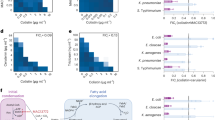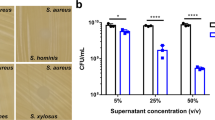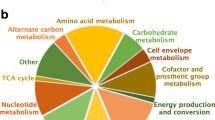Abstract
Arising from: S. Brinster et al. Nature 458, 83–86 (2009)10.1038/nature07772; Brinster et al. reply
Recently, Brinster et al.1 suggested that type II fatty-acid biosynthesis (FASII) is not a suitable antibacterial target for Gram-positive pathogens because they use fatty acids directly from host serum rather than de novo synthesis. Their findings, if confirmed, are relevant for further scientific and financial investments in the development of new drugs targeting FASII. We present here in vitro and in vivo data demonstrating that their observations do not hold for Staphylococcus aureus, a major Gram-positive pathogen causing several human infections. The observed differences among Gram-positive pathogens in FASII reflects heterogeneity either in fatty-acid synthesis or in the capacity for fatty-acid uptake from the environment.
Similar content being viewed by others
Main
The effect of serum in downregulating FASII in S. agalactiae observed by Brinster et al.1 suggests redundancy in fatty-acid synthesis upon exposure to a fatty-acid-rich environment. We confirmed that serum leads to a downregulation of S. agalactiae fab genes, but demonstrated unaltered fab expression in S. aureus (Fig. 1a). This might be due to differences in exogenous fatty-acid uptake, for example, it may be driven by cell-membrane hydrophobicity. S. aureus adapts its membrane hydrophobicity to escape innate-immune molecules, such as antimicrobial peptides and amphipathic fatty acids2,3, reiterating the specificity of host–pathogen interactions4,5.
a, Transcription levels of fab genes in mid-logarithmic S. agalactiae (left panel) in Todd Hewitt medium and S. aureus (right panel) in Mueller Hinton (MH) medium, with or without 50% human serum. The fold change was calculated using the standard curve method with gyrA as control (average ± s.d.; n = 4). b, Growth of wild-type (empty pAJ96 vector) and fabI antisense S. aureus strains in liquid MH with and without 150 ng ml-1 tetracycline (left panel) and MH + 50% human serum with and without 250 ng ml-1 tetracycline (right panel) (n = 2). The right panel also shows growth of fabI antisense S. aureus (induced with 250 ng ml-1 tetracycline) with 12-hour serum pre-adaptation (dotted blue line) (n = 2). Values are represented as averages ± s.d. c, Growth of wild-type (empty pAJ96 vector) and fabI antisense strains on solid medium with 20% human serum or 0.1% Tween-80 and incubated for 24 hours at 37 °C. FabI antisense is induced by adding 300 ng ml-1 tetracycline (MH + Tween-80) and 500 ng ml-1 tetracycline (MH + 20% human serum). d, In vivo activity of CG400549 against S. aureus in mouse peritonitis model. Percentage survival is shown after single oral dose (positive control is linezolid).
Validating the effect of exogenous fatty acids for S. aureus requires inactivation of the drug target. Knockdown of enoyl-acyl-carrier-protein (ACP) reductase (FabI), a key enzyme in S. aureus FASII, was achieved by expression of tetracycline-induced fabI antisense RNA, which has previously been shown to have target selectivity6. In contrast to S. agalactiae1, we observed that fabI downregulation severely compromised S. aureus growth in both the absence and presence of serum (Fig. 1b and c), Tween-80 and oleic and stearic fatty acids (data not shown). To show whether S. aureus can adapt to serum fatty acid, we pre-incubated the fabI antisense strain for 12 hours in 50% serum. Even after this long fatty-acid exposure, the fabI antisense strain was growth-compromised in 50% serum (Fig. 1b). These differences can be explained by mechanistic and physiological diversity among bacterial FASII enzymes7. Whereas streptococci have FabK as the ACP reductase, staphylococci possess FabI as the fatty-acid elongation counterpart7. Additionally, only streptococci possess FabM, a cis–trans isomerase, suggesting that they have a different mechanism for formation of fatty acids8,9.
Brinster et al.1 reported highly increased minimum inhibitory concentrations (MICs) in the presence of serum for hydrophobic compounds like cerulenin (which targets FabB/FabH) and triclosan (targeting FabI) for several Gram-positive pathogens10,11. We tested the inhibitory activities of these compounds, and also platensimycin12 (targeting FabF/FabB) and CG400549 (targeting FabI; ref. 13). All inhibitors lost activity completely against S. agalactiae when these bacteria were grown in the presence of serum or Tween-80 (Table 1), suggesting exogenous serum compensatory mechanisms. However, for S. aureus serum or Tween-80 had little impact on the MICs of FASII inhibitors. The slightly increased MIC values for triclosan are due to its significant plasma protein binding (about 99.5%) (Table 1). Furthermore, pre-incubation with exogenous fatty acids did not rescue the growth inhibition of S. aureus by CG400549 (data not shown). To determine whether serum inhibits cellular fatty-acid synthesis, we measured the incorporation of [1-14C]-acetate into membrane fatty acids. Serum had no significant effect on [1-14C]-acetate incorporation in S. aureus, suggesting that these bacteria continue fatty-acid synthesis even in the presence of serum. In contrast, for S. agalactiae we observed a significant decrease in [1-14C]- acetate incorporation in the presence of serum (data not shown). These results suggest functional differences in FASII pathways among different Gram-positive pathogens.
Final validation of drug targets is accomplished by in vivo pharmacodynamics. We tested CG400549 in a mouse peritonitis model and observed a dose-dependent survival of mice (Fig. 1d). Brinster et al.1 pointed out that bacterial adaptation to serum fatty acid is a gradual process. We observed that dosing of CG400549 in neutropenic mice, 6 hours after systemic infection (which allows host adaptation), killed about log10[colony-forming units] = 1.7 ± 0.3 in infected spleens (in untreated controls no bacteria were killed). These results and earlier reports on the efficacy of FabI inhibitors in rodent models14, including the clinical efficacy of Isoniazid, a FASII inhibitor in Mycobacterium tuberculosis15, argue against the broad claims by Brinster et al.1 that FASII is not a pharmaceutically attractive target.
Methods
S. aureus ATCC29213 and S. agalactiae NEM316 strains were used. Expression levels of FASII genes and the control gyrA were determined using quantitative real-time polymerase chain reaction (PCR). FabI antisense6 was cloned into the tetracycline-inducible pAJ96 vector (A. Neill, University of Leeds, UK) and electroporated into RN4220(pSTE2) (T. Hauschild, University of Bialystok, Poland). Swiss mice were intraperitoneally infected with S. aureus (108 colony-forming units) and immediately treated orally with CG400549 (percentage survival). Neutropenic mice were infected with S. aureus and dosed orally 6 hours post-infection with CG400549 (three times a day at 100 mg kg-1) for two days and killed to determine spleen colony-forming unit counts. References were purchased from Fasgen (triclosan), Sequoia Products (linezolid/cerulenin), Interchim (CG400549) and BioAustralis (platensimycin).
References
Brinster, S. et al. Type II fatty acid synthesis is not a suitable antibiotic target for Gram-positive pathogens. Nature 458, 83–86 (2009)
Weidenmaier, C. et al. DltABCD- and MprF-mediated cell envelope modifications of Staphylococcus aureus confer resistance to platelet microbicidal proteins and contribute to virulence in a rabbit endocarditis model. Infect. Immun. 73, 8033–8038 (2005)
Peschel, A. et al. Staphylococcus aureus resistance to human defensins and evasion of neutrophil killing via the novel virulence factor MprF is based on modification of membrane lipids with l–lysine. J. Exp. Med. 193, 1067–1076 (2001)
Koul, A., Herget, T., Klebl, B. & Ullrich, A. Interplay between mycobacteria and host signalling pathways. Nature Rev. Microbiol. 2, 189–202 (2004)
Finlay, B. B. & Cossart, P. Exploitation of mammalian host cell functions by bacterial pathogens. Science 276, 718–725 (1997)
Ji, Y. et al. Validation of antibacterial mechanism of action using regulated antisense RNA expression in Staphylococcus aureus . FEMS Microbiol. Lett. 231, 177–184 (2004)
Marrakchi, H., Zhang, Y. M. & Rock, C. O. Mechanistic diversity and regulation of Type II fatty acid synthesis. Biochem. Soc. Trans. 30, 1050–1055 (2002)
Altabe, S., Lopez, P. & de Mendoza, D. Isolation and characterization of unsaturated fatty acid auxotrophs of Streptococcus pneumoniae and Streptococcus mutans . J. Bacteriol. 189, 8139–8144 (2007)
Zhang, Y. M. & Rock, C. O. Membrane lipid homeostasis in bacteria. Nature Rev. Microbiol. 6, 222–233 (2008)
Omura, S. Cerulenin. Methods Enzymol. 72, 520–532 (1981)
Heath, R. J., White, S. W. & Rock, C. O. Lipid biosynthesis as a target for antibacterial agents. Prog. Lipid Res. 40, 467–497 (2001)
Wang, J. et al. Platensimycin is a selective FabF inhibitor with potent antibiotic properties. Nature 441, 358–361 (2006)
Yum, J. H. et al. In vitro activities of CG400549, a novel FabI inhibitor, against recently isolated clinical staphylococcal strains in Korea. Antimicrob. Agents Chemother. 51, 2591–2593 (2007)
Payne, D. J. et al. Discovery of a novel and potent class of FabI-directed antibacterial agents. Antimicrob. Agents Chemother. 46, 3118–3124 (2002)
Vilcheze, C. et al. Transfer of a point mutation in Mycobacterium tuberculosis inhA resolves the target of isoniazid. Nature Med. 12, 1027–1029 (2006)
Author information
Authors and Affiliations
Ethics declarations
Competing interests
Competing financial interests: all authors are members of an antimicrobial drug discovery group working for a pharmaceutical company.
PowerPoint slides
Rights and permissions
About this article
Cite this article
Balemans, W., Lounis, N., Gilissen, R. et al. Essentiality of FASII pathway for Staphylococcus aureus. Nature 463, E3 (2010). https://doi.org/10.1038/nature08667
Received:
Accepted:
Issue Date:
DOI: https://doi.org/10.1038/nature08667
This article is cited by
-
Exogenous fatty acids affect membrane properties and cold adaptation of Listeria monocytogenes
Scientific Reports (2022)
-
Environmental fatty acids enable emergence of infectious Staphylococcus aureus resistant to FASII-targeted antimicrobials
Nature Communications (2016)
-
Systems-level antimicrobial drug and drug synergy discovery
Nature Chemical Biology (2013)
-
Structure, function and selective inhibition of bacterial acetyl-coa carboxylase
Applied Microbiology and Biotechnology (2012)
Comments
By submitting a comment you agree to abide by our Terms and Community Guidelines. If you find something abusive or that does not comply with our terms or guidelines please flag it as inappropriate.




